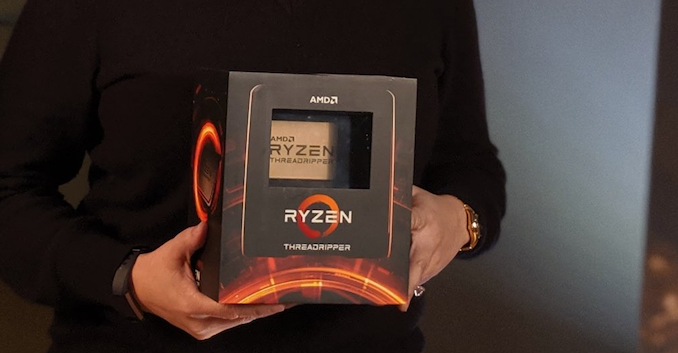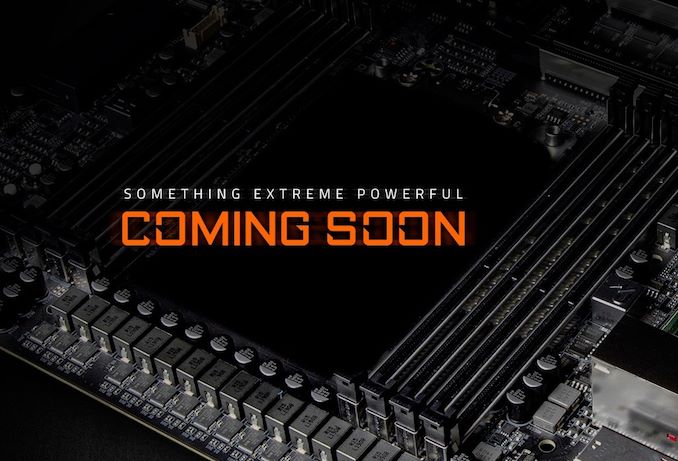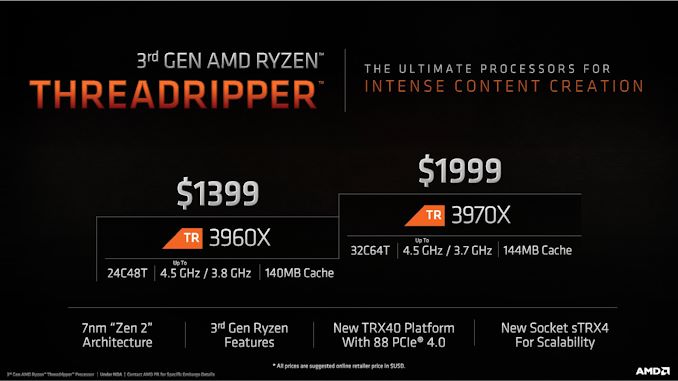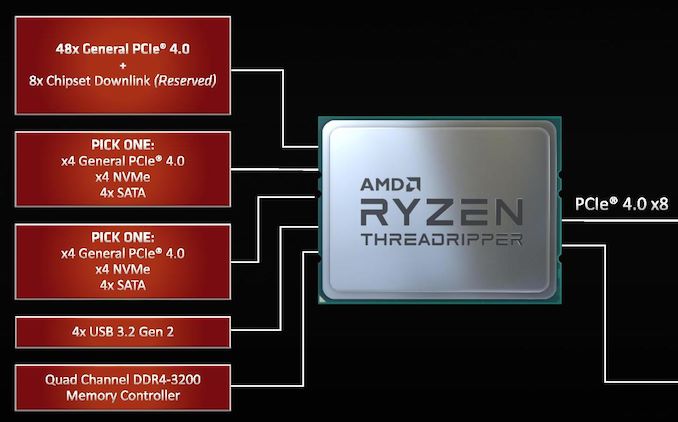AMD Q4: 16-core Ryzen 9 3950X, Threadripper Up To 32-Core 3970X, Coming November 25th
by Dr. Ian Cutress on November 7, 2019 9:00 AM EST3rd Gen Ryzen Threadripper, Up to 32-Cores
It’s the product a lot of users have been waiting for. Ever since AMD introduced the world to its Rome processors, with up to 64 cores based on 7nm chiplets and the Zen 2 microarchitecture, rumors have been swirling about what exactly the corresponding Threadripper platform will bring. We now have the answers to your questions.

From CEO Dr. Lisa Su's Twitter
The two processors that AMD will be initially launching in the 3rd Generation Ryzen Threadripper family are the TR 3960X and the TR 3970X. These are 24-core and 32-core parts respectively, built using four chiplets and one IO die in a Rome-sized package. Both CPUs will feature a 280 W TDP, and offer boost frequencies up to 4.5 GHz.
| AMD HEDT SKUs | |||||||
| Cores/ Threads |
Base/ Turbo |
L3 | DRAM 1DPC |
PCIe | TDP | SRP | |
| Third Generation Threadripper | |||||||
| TR 3970X | 32 / 64 | 3.7 / 4.5 | 128 MB | 4x3200 | 64 | 280 W | $1999 |
| TR 3960X | 24 / 48 | 3.8 / 4.5 | 128 MB | 4x3200 | 64 | 280 W | $1399 |
| Second Generation Threadripper | |||||||
| TR 2990WX | 32 / 64 | 3.0 / 4.2 | 64 MB | 4x2933 | 64 | 250 W | $1799 |
| TR 2970WX | 24 / 48 | 3.0 / 4.2 | 64 MB | 4x2933 | 64 | 250 W | $1299 |
| TR 2950X | 16 / 32 | 3.5 / 4.4 | 32 MB | 4x2933 | 64 | 180 W | $899 |
| TR 2920X | 12 / 24 | 3.5 / 4.3 | 32 MB | 4x2933 | 64 | 180 W | $649 |
| Ryzen 9 3950X | 16 / 32 | 3.5 / 4.7 | 32 MB | 2x3200 | 24 | 105 W | $749 |
There’s a lot to unpack here.
The 32-core TR 3970X has 64 threads, a base frequency of 3.7 GHz, a turbo frequency of 4.5 GHz, comes with 64 PCIe 4.0 lanes, four memory channels of DDR4-3200 (1DPC), and will retail at $2000. To put that in perspective, it wasn’t too long ago that for that money you would only get 10 cores.
The 24-core TR 3960X offers almost the same, but trades a few cores for a 3.8 GHz base frequency and will retail for $1399. The competition for this part is likely to be the Core i9-10980XE, which has 18-cores and has a tray price of $979.
Both CPUs have 128 MB of L3 cache, due to the use of four chiplets. We asked AMD if these CPUs have 4 chiplets inside the package and 4 dummy ones, like the dummy silicon in previous Threadripper products – AMD confirmed that there will only be four chiplets in each package. This means that each CPU will be in a symmetrical 6+6+6+6 or 8+8+8+8 configuration, minimizing the total amount of silicon AMD has to ship.
Each CPU supports four channels of DDR4-3200. We confirmed that this included support for ECC UDIMMs on a board-by-board basis, but does not include RDIMM or LRDIMM support. AMD did state that these new CPUs are validated for the 32 GB DDR4 modules coming onto the market, which makes a realistic maximum DRAM support of 256GB (8 x 32GB).
For performance, AMD gave us some numbers comparing each CPU to the 18-core Core i9-9980XE from Intel. In common workstation tasks, such as program compilation, Adobe Premier transcoding, and rendering, AMD is quoting a +22-31% performance gain for the 24-core part, and a +36-49% uplift for the 32-core part.
When we asked AMD about AI performance, they stated that while AI is an emerging workload in the enterprise space, for the workstation market these products are targeting exactly what their customers are requesting today: ‘Threadripper and Zen 2 have been taken by customers looking at content creation, CAD, and code work/compilation. AI is still an emerging vertical in the workstation at this time.’
Compared to previous generation Threadripper parts, the new 3rd Gen Ryzen Threadripper features a central I/O die in the hardware which all the chiplets are connected to. This I/O die has all the PCIe lanes and the DRAM channels, which means that the memory latency issues with the 1st/2nd Generation Threadripper should no longer be present with the new chips. Both chips launched here have 64 PCIe 4.0 lanes, which are split into 48x general purpose lanes, 8 lanes for the CPU-to-chipset communications, and 8 lanes for I/O. This means that users can have the following CPU configurations:
- 1st root complex: x16 or x8/x8
- 2nd root complex: x16 or x8/x8
- 3rd root complex: x16 or x8/x8
- Chipset downlink: x8
- Pick one: PCIe 4.0 x4 slot, 1 x NVMe PCIe 4.0 x4, 4x SATA
- Pick one: PCIe 4.0 x4 slot, 1 x NVMe PCIe 4.0 x4, 4x SATA
Obviously things like SATA ports can also come off the chipset. We discuss the new chipset on the next page. But one thing to note here is the CPU-to-chipset connection.
For AMD Ryzen on most AM4 chipsets, for first generation and second generation Threadripper, and for every Intel platform in recent memory, the connection between the CPU and the chipset has been the equivalent of a PCIe 3.0 x4 link. This link, as the industry has progressed into the world of NVMe storage, has become a bottleneck for any user wishing to push a modern PCIe-based storage drive along with anything else on the same uplink. AMD increased it for the X570 motherboard generation to PCIe 4.0 x4 for mainstream, doubling the bandwidth from its closest competitor, but what AMD is doing with the new 3rd Gen Threadripper is increasing that link bandwidth by a factor of two again.
With this CPU, and the TRX40 chipset, users now have a PCIe 4.0 x8 link between the CPU and the chipset. This is the equivalent of a PCIe 3.0 x16 link, or a previous generation full GPU slot. It means that users could, if they wanted, push four times as much data up and down that link. To be honest, this sort of thing should have happened a while go on the Intel side of the equation, so I’m glad that AMD is pushing the boundaries here. It’s also one reason for 3rd Gen Threadripper having a new socket.

From GIGABYTE's Aorus Facebook Page
Yes, you read that correctly: the new Threadripper requires a new socket. Because of the new CPU-to-chipset link, as well as a few ‘forward looking adjustments and scalability’, we now have what AMD are calling an sTRX4 socket and related TRX40 motherboards. AMD wasn’t prepared to make a statement on the record about committing to this socket long term, but stated that adjustments were made to ensure the future longevity of the platform, so one could infer at least one more generation on this new socket. Technically it is the same 4094 pins as the previous socket, and even the keying (the marks along the side of the processor) is the same, however AMD stated that due to this new PCIe 4.0 x8 requirement, if you put a new processor in an old motherboard (or vice versa), it just won’t work.
As for the motherboards, expect a few new parts to enter the market. More details on TRX40 on the next page.
But motherboards aside, I just want to point out that AMD's numbering scheme leaves some room at the top. Above the 3970X, there leaves the potential for a 3980X and 3990X. We know that these CPUs are based on the same layouts as AMD's Rome-based EPYC processors, and those are offered with 48-core and 64-core variants. We may be at a practical TDP limit of 280W, but if there's more room at the top, AMD might take it. At this point, AMD has said that they are only announcing two SKUs today and declined to answer the question of whether any more are coming.
| AMD HEDT SKUs | |||||||
| Cores/ Threads |
Base/ Turbo |
L3 | DRAM 1DPC |
PCIe | TDP | SRP | |
| Third Generation Threadripper | |||||||
| TR3970X + 20 ? | There's some space here for more SKUs | ||||||
| TR3970X + 10 ? | |||||||
| TR 3970X | 32 / 64 | 3.7 / 4.5 | 128 MB | 4x3200 | 64 | 280 W | $1999 |
| TR 3960X | 24 / 48 | 3.8 / 4.5 | 128 MB | 4x3200 | 64 | 280 W | $1399 |












171 Comments
View All Comments
Death666Angel - Thursday, November 7, 2019 - link
What are you talking about? A short trip to "geizhals.de" shows 16 mini ITX AM4 motherboards available, 3 X570, 2 X470, 3 X370, 4 B450, 3 B350 and 1 A320. There is even an mini STX motherboard, if you want to buy a whole barebones PC (DeskMini A300).And a smart TV has the smart stuff integrated. You are talking about an HTPC.
Midwayman - Thursday, November 7, 2019 - link
I really wish all the PCIe lanes were available at lower core counts. Its not hard to have a lot of I/O needs without needing a stupid amount of cores. It really sucks when you go to install an expansion card or NVME only to find out that its going to drop your GPU lanes from 16x to 8x.DigitalFreak - Thursday, November 7, 2019 - link
My understanding is that Ryzen actually has 32 PCIe lanes available on the processor, at least in the 1xxx and 2xxx series. They only exposed 24 of them (16 GPU, 4 NVMe, 4 to the chipset) for some reason. Limitation of the socket?John_M - Friday, November 8, 2019 - link
It is obviously limited by the AM4 socket, though not arbitrarily - it was a conscious design choice. Some of them are used internally bt the SoC for SATA, USB, etc. Actually, If you take a look at Raven Ridge and Picasso all 32 lanes are indeed used: 8 to the discrete GPU slot, 4 for NVMe, 4 to the chipset and 16 to the integrated GPU, SATA, USB, etc.Kevin G - Thursday, November 7, 2019 - link
Kind of irked that there is a new socket for TR. The Epyc side didn't need a new socket for PCIe 4.0 and that invoked a few changes too (like an additional PCIe lane for OoBM). At the very least, it would have been nice to have had the 3rd gen TR parts work in earlier motherboards for an upgrade path even if that meant that the IO was PCIe 3.0 only and the chipset link was effectively 4x PCIe 3.0. The centralized IO chip is likely a huge reason for the generational performance leap on top of the Zen2 improvements. That's something original socket TR4 owners probably want.DigitalFreak - Thursday, November 7, 2019 - link
Realistically, how many people actually upgrade a CPU without upgrading the motherboard? That argument is getting old.TheinsanegamerN - Thursday, November 7, 2019 - link
so old. I have never upgraded a CPU only, because motherboard features have always been just as important.Death666Angel - Thursday, November 7, 2019 - link
What are the benefits you got from your motherboard after upgrading from a Z170 to a Z390 motherboard?Let's look at the Asus Z170-P and the Asus Z390-P:
4 DDR4 DIMM slots
x16 and x4 GPU slots
Z170 has 2 PCIe x1 & 2 PCI slots vs Z390 4 PCIe x1 slots
Z390 has 2 NVME slots (x2/SATA + x4) and wifi M.2 vs Z170 has 1 NVME x4 slot
Z170 has USB C on the IO vs Z390 not but Z390 has more USB ports in general (other Z170 have more USB) and Z390 has USB 3.1 (10 Gbps)
Z390 has RGB and a water pump header
That is not a lot of features you gain for a product that launched in 2015 vs 2018. Not many people need many USB 3.0 ports. At one point in time every motherboard upgrade would bring with it better USB and SATA speeds that actually mattered, better fan controls and better DDR speeds. But it's slowed down a lot. I could mod my Haswell board BIOS to allow NVME booting from a 15€ add in card, the board had USB 3.0, SATA III, good fan controls. When it comes to pure features, my X570 doesn't really offer anything more. And I'm sure a lot of people would have liked to upgrade just their 7700K to a 8700K, getting an automatic 50% increase in a lot of tasks and kept their own board. If AMD does indeed keep their AM4 platform for 4 generations with Zen 3 next year that will be a great accomplishment for them, the consumer and the environment.
Threska - Thursday, November 7, 2019 - link
I did, but then not everyone throws away the car every time they buy new tires.Death666Angel - Thursday, November 7, 2019 - link
We've really been conditioned by Intel not allowing it and doing little generation to generation to think that. I've upgraded in the AM3 days from a 2 core to a 4 core and then a 6 core. Some friends bought a first gen Ryzen CPU and now upgraded to Gen 3 and they are happy because PCIe is basically the only thing they miss out on. I also upgraded in the Athlon 64 days, I think I upgraded a socket 939 motherboard from a single core to a dual core, but I'm not too sure anymore.With Intel, there was no way to upgrade from a 2700k SB to a 4770k Haswell without a motherboard change. Realistically, there was no great motherboard feature upgrade in that time. Z68 boards already had USB 3.0 and SATA III, DDR3. The big jump came with the *Lake architecture that enabled NVME slots and DDR4. And then Intel allowed another generation of 4 core CPUs for that generation before breaking compatiblity when the core counts increased.
It is always interesting when people argue against good features for seemingly no reason other than to defend a multi billion dollar corporation.